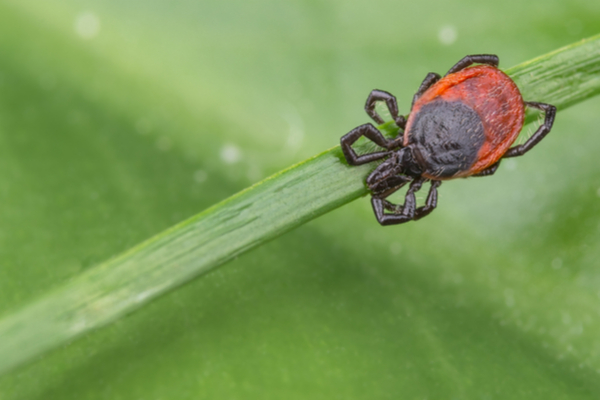Deer Tick (Blacklegged Tick)

BEHAVIOR
Blacklegged deer ticks climb grass and shrubs to wait for a passing host, and move very laterally. They concentrate on vegetation located in transitional zones. They’re common around paths, fences, animal trails, or the less-densely overgrown edges of forests. In general, they hunt (or “quest”) in areas frequented by animal hosts. Other habitats most likely to harbor ticks are animal dens, nests or burrows. Along with deer, deer ticks frequently latch onto skunks, raccoons, opossums, and mice (especially white-footed mice and deer mice).
When they attach to humans, Blacklegged deer ticks tend to feed at the back of the neck, near the base of the skull. Crucially, however, ticks wander around new hosts for about four hours before they attach themselves to a feeding place. Even after they begin feeding, a tick won’t transmit diseases, via its saliva, for another 6 to 8 hours. You have 10-12 hours to remove a deer tick before it may transmit Lyme disease to you.
CONTROL AND PREVENTION
Keep your grass cut low, especially around fence lines, sheds, trees, shrubs, swing sets, and other structures. Don’t neglect grass trimming around structural perimeters such as your siding or fences. You should also remove weeds, woodpiles, and other related debris from around your yard. Cluttered yards attract mice, and mice often carry ticks. Leaf litter is also attractive to ticks, especially nymphs.
Install motion-sensing lights or sprinkler systems to keep animals from getting too close to your home. Keep the lids to your garbage cans secure to prevent animals from raiding them for food. If you have a bird feeder, make sure its seed isn’t leaking onto the ground where mice could feed on it. Finally, consider put in chimney and attic vents to stop squirrels, raccoons, birds, and bats out of your home. Ticks frequently infest homes after their hosts carry them inside. By blocking the hosts, you can also block the ticks.
APPEARANCE
Female blacklegged deer ticks are about ⅛” long. Males are smaller at around 1/16” long. The tick’s flat, oval body is orange-brown to reddish-brown. Its legs are a dark reddish-brown or black (hence the other part of their common name).
PROFESSIONAL CONTROL
Plunkett’s technicians treat the exterior perimeter of either your home or your entire property with residual pesticide. We may also perform our exterior perimeter rodent control program to control possible hosts.
If you think you have a Blacklegged deer tick problem, give Plunkett’s a call right away. We’ll be able to identify your problem, wipe it out, and make sure it doesn’t happen again. Blacklegged deer ticks are a serious medical concern, so if you’re concerned about an infestation, don’t wait! Call today.







